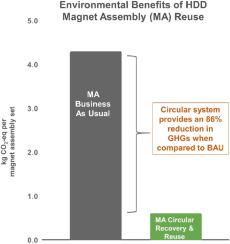Resources, Conservation and Recycling ( IF 11.2 ) Pub Date : 2021-06-15 , DOI: 10.1016/j.resconrec.2021.105694 Kali Frost , Ines Sousa , Joanne Larson , Hongyue Jin , Inez Hua

|
Hard disk drives (HDDs) are prioritized by many stakeholders for implementation of circular economy initiatives due to their value and critical material content. Rare earth (RE) magnets are of particular interest for recovery and reuse (R&R), but the business model has not been demonstrated for feasibility at a large scale. This study assessed a pilot-scale R&R process for RE magnet assemblies and compared the environmental impacts with business as usual (BAU) (i.e. shredding whole HDDs at end-of-life), using life cycle assessment (LCA). The process was implemented by two major stakeholders in the HDD value chain – a large HDD user (i.e., data center) and a HDD manufacturer. Primary data on materials, transportation, and electricity inputs were collected from dismantling 6100 end-of-life HDDs in a data center, transporting the retrieved RE magnet assemblies to a HDD manufacturer, and placing them in new HDDs for reuse. LCA results indicated an 86% reduction in global warming potential: 3.70 kg CO2-eq per set of magnet assemblies from one HDD compared to the BAU system. The environmental benefit was predominantly due to foregoing the RE magnet production, which is the most energy and chemically intensive process within the magnet assembly. This pilot also highlighted the benefits of a collocated R&R process with data centers to address (1) data security concerns, (2) transboundary shipments of e-waste (whole HDDs vs. components), and (3) the need for a qualified manufacturing process for disassembly, which is required to reuse components in new HDDs.
中文翻译:

硬盘驱动器稀土磁铁循环回收过程对环境的影响
硬盘驱动器 (HDD) 因其价值和关键材料内容而被许多利益相关者优先用于实施循环经济计划。稀土 (RE) 磁铁在回收和再利用 (R&R) 方面特别受关注,但该商业模式尚未在大规模可行性方面得到证明。本研究评估了 RE 磁体组件的中试规模 R&R 流程,并使用生命周期评估 (LCA) 将环境影响与照常营业 (BAU)(即在使用寿命结束时切碎整个 HDD)进行了比较。该流程由 HDD 价值链中的两个主要利益相关者实施——大型 HDD 用户(即数据中心)和 HDD 制造商。材料、运输和电力输入的主要数据是通过拆除数据中心的 6100 个报废 HDD 收集的,将回收的 RE 磁体组件运送到 HDD 制造商,并将它们放入新的 HDD 中以供重复使用。LCA 结果表明全球变暖潜能值降低了 86%:3.70 kg CO与 BAU 系统相比,来自一个 HDD 的每组磁体组件2 -eq。环境效益主要是由于取消了 RE 磁体生产,这是磁体组件中能源和化学强度最高的过程。该试点还强调了与数据中心并置的 R&R 流程的好处,以解决 (1) 数据安全问题,(2) 电子废物的跨境运输(整个 HDD 与组件),以及 (3) 对合格制造的需求拆卸过程,这是重新使用新硬盘驱动器中的组件所必需的。











































 京公网安备 11010802027423号
京公网安备 11010802027423号